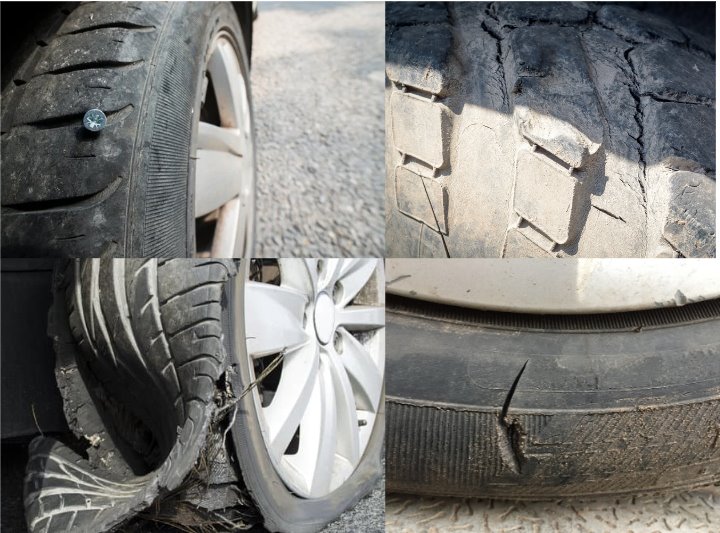What is Car Tyre Lifespan & When to Replace Your Tyres?

Tyres are the most important thing that ensures the safety of the driver and passengers, as they are the only thing that makes contact with the road surface. Hence, you should take special care of them and look out for damages, if any.
The following article will orient you to the potential causes of tyre damage and the types of tyre damage. This will eventually help you to spot tyre damage on your own and take the necessary action as soon as possible.

Table of Contents

What are the Causes of Tyre Damage?
There are many tyre damage types. Some of them are mentioned below:
1. Bad Suspension:
Bad suspension results in tyre wear where a unique wear pattern is developed, known as “scalloping” or “cupping”, showing regular patches of tyre wear.
2. Overinflated Tyres:
Overinflated tyres results in overloading in the center of the tyre which eventually causes center wear and lastly, a blowout.
3. Underinflated Tyres:
Underinflated tyres result in excessive wear on both sides, which deteriorates the quality of the tyre and decreases its life.
4. Misaligned Tyres:
Misaligned tyres are responsible for faster tyre wear on one side, which gradually deteriorates the tyre quality, decreasing the tyre's life.
Common Tyre Damages and Ways to Fix Them
1. Punctures:
Punctures are the most common type of tyre damage where sharp objects get into the tread of the tyres. This can get serious if the objects penetrate deep enough, making the air escape through them. This is divided into two categories: the slow puncture and the rapid puncture.
If you get a puncture while driving, carry out a roadside repair to get a temporary fix. If the damage is severe, you may need to change the tyre. However, if you want to fix it on your own, you should keep a tyre repair kit handy in your vehicle.
2. Burst:
Driving on well-maintained roads are crucial to maintain the durability of your tyres. Steer away from driving on rough or uneven roads that will deterioratThis is the most severe type of damage caused to the tyres. After a tyre burst, the tyre is no longer able to hold air in it, and the structural integral of the tyre gets compromised.
Once your tyre bursts, it cannot be fixed any more. You need to replace your burst tyre with a new one as soon as possible.
3. Cracks:
With proper maintenance you can significantly improve your tyre conditions. These include balancing, correct alignment, and regular rotations of your tyres.Cracks on the sidewalls or treads of the tyres are inevitable and will occur sooner or later. Various factors, such as the age of the tyre, harsh road conditions, or exposure to UV rays, result in the cracking of tyres. This may cause tyre burst if not taken care of.
Fixing a cracked tyre can result in a change in its structural integrity. Hence, it is always better to check the seriousness of the damage and get your tyres replaced, as they tend to increase in size over time.
4. Tyre Wall Damage:
The tyre wall is the outer portion of the tyre that faces the wheel. Tyre wall damage is seen in two forms: bulges and cuts. It occurs as a combined effect of low tyre pressure and penetration of shard objects.
There is no way to fix this, and once the tyre wall is damaged, you shouldn’t drive unless the tyres are replaced. Damage to the tyre wall symbolises the loss of the tyre's structural integrity.
5. Irregular Tread Wear:
You adhere to the manufacturer’s recommended load limits. Overloading your veThe irregular tread wear occurs after a long period of time and does not pose much threat to the passengers and the driver. There are three types of irregular tread wear, and they are:
- Centre Wear: The centre part gets worn out.
- Heel and Toe Wear: In this, one side wears out faster due to misalignment.
- One-Sided Wear: Occurs on either the exterior or interior of the tyre.
In this case, you need to take a closer look at your tyres and observe the early signs of tyre wear. If present, get your tyres properly aligned, and you will be good to go. hicle as this will cause them to wear out more quickly.
How to Avoid Tyre Damages?
The following section mentions some of the tips that will help you to avoid tyre damage:
Remove Embedded Objects:
If you notice certain objects embedded in the tyre tread, get them removed as soon as possible with the help of pliers.
Maintain Tyre Pressures:
Maintaining proper tyre pressures will protect your tyres from getting exposed to unwanted additional forces and pressure.
Clean Off Spilled Oil:
Oil and other chemical compounds tend to deteriorate the tyre quality; hence, clean off any spilt oil or compound as soon as the tyre comes in contact with them.
Avoid Potholes:
Indian roads are filled with potholes and its nearly impossible to drive avoiding them. However, if your manage to do so, it will save your tyres from sidewall damages consequently increase the longevity.
Avoid Kerbs:
Although it is a very obvious instruction, new drivers find it difficult to avoid Kerbs while parking. Bumping into them increases the risk of sidewall damage.
Check Your Tyres:
Check your tyres on a regular basis to rule out any sign of potential damage and if you spot any minute damage, consult a tyre specialist and get it fixed.
It is a very obvious thing for tyres to get worn off after a period of time. However, with proper use and care, you can increase tyre life and reduce the risk of accidents. Therefore, check your tyres on a regular basis and follow the tips discussed in the article above to avoid tyre damages!
















